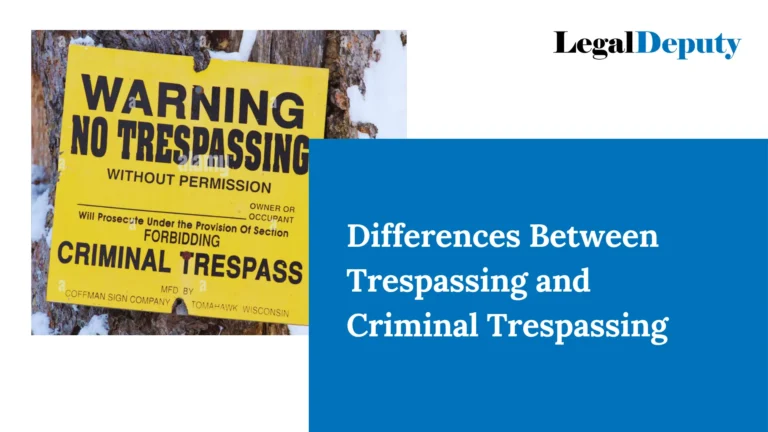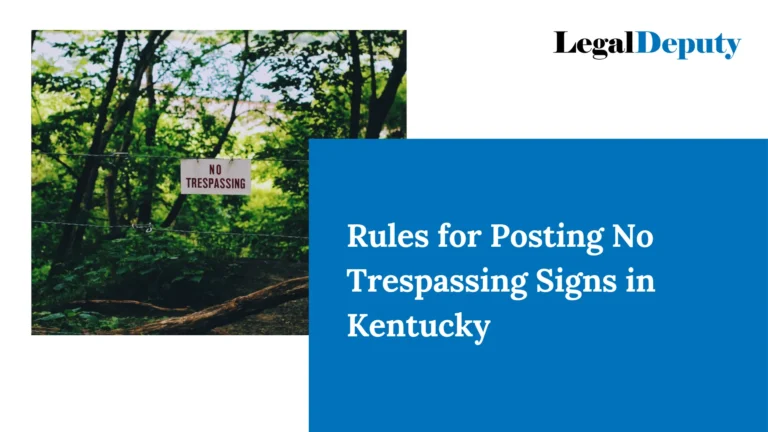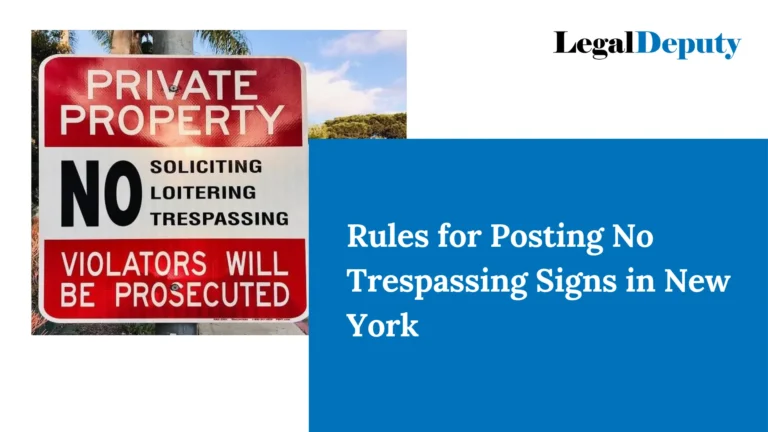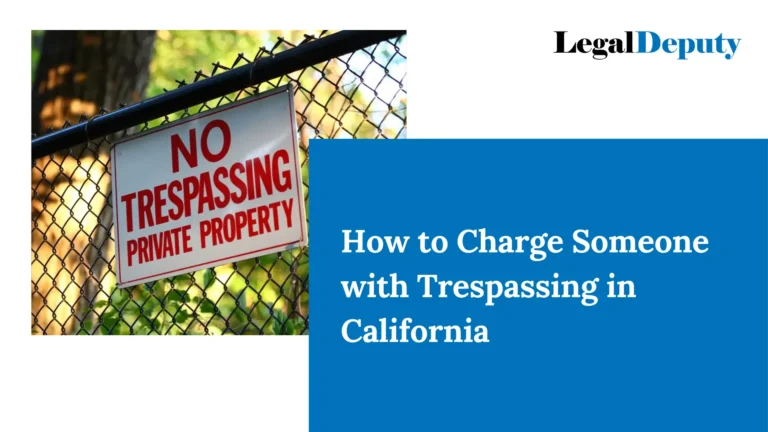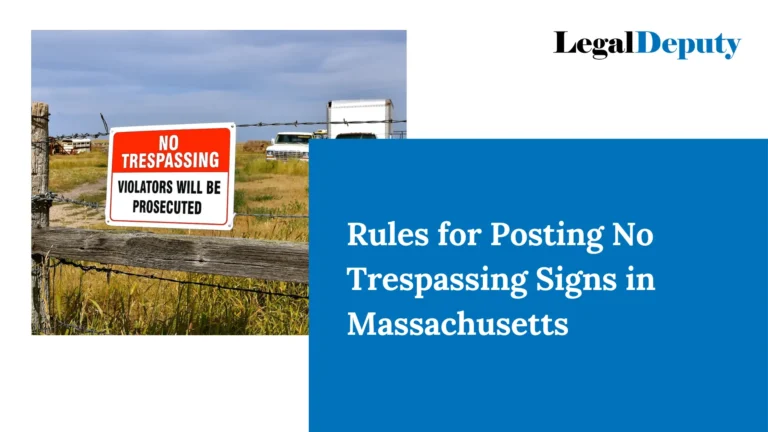California No Trespassing Sign Requirements – All You Need To Know
In the intricate dance between property rights and public access, no trespassing signs stand as silent guardians, asserting the boundaries that protect what’s rightfully yours. Navigating California’s legal landscape requires more than just a passing understanding of the law—it demands a proactive stance.
As we delve into the specifics of California No Trespassing Sign Requirements, we embark on a journey to empower property owners with the knowledge they need. Imagine these signs not just as placards, but as sentinels standing watch over your peace of mind.
In this exploration, we demystify the intricacies, discussing types, placement, and the crucial role these signs play in fortifying your property rights. Join us as we illuminate the path to a safer and legally sound haven, where every sign tells a story of protection and resilience.
Understanding California Trespassing Laws: Navigating the Legal Landscape
Embarking on the journey to fortify your property begins with a deep dive into the nuanced realm of California trespassing laws. In the Golden State, where property rights are held in high regard, comprehending the legal intricacies is akin to holding the key to your kingdom.
Legal Foundations:
California trespassing laws, rooted in the principle of protecting private property, define the boundaries between public access and individual rights. The law acknowledges the inherent right of property owners to control who enters their premises, and no trespassing signs become a crucial tool in asserting and reinforcing these rights.
Importance of Signage:
While the laws are clear, the implementation requires a proactive approach. No trespassing signs act as tangible expressions of your legal prerogatives. Without proper signage, the legal process becomes murkier, and the efficacy of your claims may be compromised. A well-placed, clearly visible sign, on the other hand, serves as a preemptive deterrent, reducing the likelihood of trespassing incidents and strengthening your legal position if an intrusion occurs.
Legal Consequences:
California trespassing laws dictate significant consequences for those who breach property boundaries. By understanding these laws and ensuring compliance with the signage requirements, property owners not only prevent unauthorized access but also bolster their ability to seek legal remedies in case of a violation.
Empowering Property Owners:
As we unravel the layers of California’s trespassing laws, it becomes evident that knowledge is power. This knowledge empowers property owners to take proactive steps, fortifying their grounds against potential intruders and ensuring a heightened sense of security.
Types of No Trespassing Signs: Choosing Your Legal Shield
In the vast tapestry of property ownership, no trespassing signs are the threads that weave a protective shield around your domain. In California, understanding the nuances of these signs is not just a matter of compliance; it’s a strategic move to safeguard what matters most to you. Let’s explore the diverse array of signs available, each with its unique characteristics and legal implications.
1. Standard No Trespassing Signs
The classics never go out of style. Standard no trespassing signs feature bold, unmistakable fonts and straightforward language. These signs, often rectangular in shape, serve as the foundational sentinels of your property boundaries. Their simplicity ensures clear communication and complies with California’s requirements for visibility and legibility.
2. Customized Signs
Sometimes, personalization is the key to making a statement. Customized no trespassing signs allow property owners to tailor their messages, incorporating specific details such as contact information, additional warnings, or even unique graphics. Beyond mere legal compliance, these signs become a personalized proclamation of your commitment to safeguarding your property.
3. No Trespassing and Surveillance Signs
For those seeking an extra layer of deterrence, combining a no trespassing message with a surveillance warning can be a strategic choice. These signs not only communicate the prohibition of unauthorized entry but also serve as a visual reminder that the property is under watchful eyes, dissuading potential intruders.
4. Bilingual No Trespassing Signs
In California’s diverse landscape, linguistic inclusivity is essential. Bilingual no trespassing signs ensure that the message is understood by a broader audience. Typically featuring English and Spanish, these signs enhance communication and compliance, reinforcing the legal standing of your property boundaries.
5. Reflective and Illuminated Signs
The protection shouldn’t fade when the sun sets. Reflective and illuminated no trespassing signs guarantee visibility even in low-light conditions, ensuring that your property remains fortified around the clock. These signs not only meet legal requirements but also contribute to a heightened sense of security.
Choosing the Right Sign for You:
The array of options may seem overwhelming, but the choice ultimately depends on your specific needs and preferences. Whether you opt for the timeless simplicity of standard signs or the personalized touch of customized ones, each sign becomes a proactive step in fortifying your property and communicating your commitment to its protection.
In the subsequent sections, we delve into the specifics of placement and legal considerations, ensuring that your chosen signs not only meet aesthetic preferences but also serve as robust guardians of your property rights in accordance with California law. Join us as we unravel the intricacies of signage, empowering you to make informed decisions and secure your sanctuary.
Placement Guidelines: Strategically Positioning Your Legal Safeguards
Choosing the right no trespassing sign is only the first step; where you place it transforms that sign into a formidable guardian of your property. In the intricate dance of California’s legal landscape, strategic placement isn’t just a matter of aesthetics—it’s a tactical move to reinforce boundaries and dissuade potential intruders.
1. Entry Points and Boundaries
Strategic sign placement begins at your property’s entry points. Whether it’s a gate, fence, or a prominent pathway, position signs where they are immediately visible. Ensure they are not obstructed by vegetation or other objects, allowing them to serve as a clear deterrent to anyone contemplating unauthorized access.
2. Regular Intervals for Large Properties
For expansive properties, it’s not enough to rely on a single sign. Distribute signs at regular intervals along the perimeter, maintaining visibility from various vantage points. This not only strengthens the physical presence of your boundaries but also ensures that your commitment to property protection is evident from every angle.
3. Eye-Level Visibility
Consider the line of sight for both pedestrians and vehicles. Install signs at eye level, ensuring they are easily seen and comprehended. Whether someone is walking along the property line or driving by, the visibility of these signs reinforces the message that unauthorized entry is prohibited.
4. Lighting Considerations
The effectiveness of your signs should not be limited by daylight. If possible, illuminate or use reflective materials to ensure visibility during nighttime hours. Lighting not only enhances the sign’s efficacy but also contributes to an overall sense of security, making it clear that your property is monitored and protected around the clock.
5. Additional Signage for Specific Areas
Tailor your sign placement to address specific concerns or vulnerable areas. For example, if you have a pool or hazardous terrain, consider additional signage to highlight potential dangers. These targeted signs not only enhance safety measures but also serve as a proactive defense against legal liabilities.
Regular Inspections and Maintenance
Once your signs are in place, conduct regular inspections to ensure they remain visible and intact. Weather, vandalism, or natural growth can impact their effectiveness. Prompt replacement or repair guarantees that your legal safeguards are consistently upheld.
Strategic Signage as a Visual Deterrent
In the eyes of the law, the placement of no trespassing signs is more than a mere formality—it’s a visual deterrent. The strategic positioning of these signs communicates a resolute commitment to property protection, setting the tone for a secure and legally compliant environment.
As we delve deeper into the legal considerations surrounding no trespassing signs, remember that the location of each sign plays a pivotal role in transforming your property into a fortress of legal protection. Join us in the next sections as we explore the legal nuances and additional layers that elevate your property’s defense against unauthorized access.
Language and Content: Crafting Clear Messages for Legal Vigilance
No trespassing signs are not just silent sentinels; they are communicative guardians that convey a clear message of boundary enforcement. In California, where legal precision matters, the language and content of these signs become critical components in the defense of your property rights. Let’s delve into the art of crafting messages that are both legally sound and humanely assertive.
1. Clarity is Key
The language on your no trespassing signs should leave no room for ambiguity. Opt for simple, direct wording that explicitly prohibits unauthorized entry. Use phrases such as “No Trespassing,” “Private Property,” or “Keep Out.” Remember, the goal is to communicate swiftly and effectively, leaving no room for misinterpretation.
2. Legally Precise Language
While clarity is essential, incorporating legally precise language enhances the validity of your signs. Familiarize yourself with California trespassing laws to ensure your signs align with legal requirements. Include information such as the legal consequences of trespassing and contact details for property owners or managers.
3. Brevity and Visibility
In the world of signage, less is often more. Keep the message concise to ensure quick comprehension, especially for passersby or individuals in motion. Consider font size and color to maximize visibility, ensuring that the message stands out against the background and is easily legible from a distance.
4. Personalization for Added Impact
While legal clarity is paramount, injecting a touch of personalization can amplify the impact of your message. Include the property owner’s name or a brief statement about the property’s intended use. This not only adds a human touch but also reinforces the authenticity of the signage.
5. Multilingual Considerations
Given California’s diverse population, consider incorporating multiple languages on your signs, especially if English and Spanish are prevalent in your community. Multilingual signs enhance accessibility and ensure that the message reaches a broader audience, contributing to a more inclusive approach to property protection.
Visual Elements for Emphasis:
Enhance the textual message with visual elements that emphasize the prohibition. Icons such as a crossed-out person or a lock symbol can reinforce the verbal message, making it universally understandable. Striking visuals serve as an additional layer of communication, transcending language barriers.
Periodic Review and Updating:
As legal landscapes evolve, so should your signage. Periodically review and update your signs to ensure they remain compliant with current laws and regulations. This proactive approach not only reflects a commitment to legal adherence but also ensures that your property remains fortified against potential legal challenges.
In the subsequent sections, we explore the legal consequences of trespassing and the specific requirements outlined by California law. Join us as we unravel the layers of legal precision and communicative strength that transform your signs into formidable protectors of your property rights.
Legal Consequences of Trespassing: Navigating the Aftermath with Vigilance
Beyond the boundaries marked by no trespassing signs lies a realm of legal consequences, where the law asserts itself to protect property owners. In the diverse landscape of California, understanding the potential ramifications of trespassing is not just about legal vigilance—it’s about safeguarding the sanctity of your space. Let’s explore the legal landscape that unfolds when those boundaries are breached.
1. Criminal Trespass Laws in California
California law categorizes trespassing as a criminal offense, and the severity of consequences varies based on the circumstances. Simple trespass, typically treated as a misdemeanor, involves unauthorized entry onto another person’s property. Aggravated trespass, involving intent to damage property or intimidate occupants, may escalate to a felony charge with more severe penalties.
2. Legal Basis Strengthened by No Trespassing Signs
The presence of well-placed, legally compliant no trespassing signs significantly strengthens the legal basis for prosecuting trespassers. Courts often consider the absence of signs as a potential defense for the accused, emphasizing the proactive role that signs play in establishing the property owner’s intent to restrict access.
3. Civil Remedies for Property Owners
In addition to criminal charges, property owners have the right to seek civil remedies against trespassers. The presence of no trespassing signs bolsters the property owner’s position in civil court, making it more likely to recover damages for any harm caused. Understanding the dual legal avenues—criminal and civil—underscores the importance of proactive property protection.
4. Importance of Documentation
For legal proceedings, documentation is key. If a trespassing incident occurs, promptly document the details, take photographs, and gather any other relevant evidence. This documentation not only aids law enforcement but also strengthens your case should civil action be necessary.
5. No Trespassing Signs as Preventive Measures
The legal consequences of trespassing are not just reactive; they are also preventive. No trespassing signs act as deterrents, dissuading potential intruders and reducing the likelihood of incidents. By communicating a clear and legally supported message, these signs contribute to a proactive defense of your property.
6. Reporting and Cooperation with Authorities
If a trespassing incident occurs, promptly report it to local authorities. Cooperation with law enforcement not only ensures a swift response but also establishes a formal record of the incident. This collaborative effort strengthens the legal foundation for prosecuting trespassers.
Educating and Empowering Property Owners:
As we unravel the legal consequences of trespassing, it becomes evident that knowledge is a formidable ally. Understanding the laws, documenting incidents, and leveraging the presence of no trespassing signs all contribute to a comprehensive strategy for property protection. This education empowers property owners to navigate the aftermath of trespassing incidents with both legal resilience and human vigilance.
In the next sections, we delve into the specifics of DIY versus professional signs and address frequently asked questions, equipping property owners with the tools to make informed decisions in their quest to fortify their property rights. Join us on this journey as we explore the intersection of legality and protection.
DIY vs. Professional Signs: Crafting Your Legal Shield with Care
In the realm of no trespassing signs, the choice between a do-it-yourself (DIY) approach and professionally crafted signs is a decision that reverberates through the corridors of property protection. Each avenue presents its own set of considerations, from cost-effectiveness to legal validity. Let’s explore the nuances of DIY and professional signs, guiding you through the process of selecting the legal shield that best suits your property.
1. DIY Signs: A Personal Touch with Caveats
DIY signs can be appealing, offering property owners the opportunity to infuse a personal touch into the messaging. Crafted with creativity and resourcefulness, these signs can reflect the uniqueness of your property. However, there are caveats. DIY signs must adhere strictly to California’s legal requirements in terms of language, size, and visibility to ensure their effectiveness in the eyes of the law.
2. Legal Validity of DIY Signs
Ensuring the legal validity of DIY signs demands meticulous attention to detail. Language must be clear and compliant, and the signs must meet specific size and visibility standards outlined by California law. While the DIY approach allows for creative expression, it also places the responsibility squarely on the property owner to navigate the legal intricacies accurately.
3. Professional Signs: Assured Compliance and Expert Craftsmanship
Turning to professional sign crafting alleviates the burden of legal compliance and craftsmanship. Companies specializing in no trespassing signs understand the intricacies of California law, ensuring that each sign meets the required standards. Professional signs are crafted with durable materials, enhancing longevity and effectiveness. The assurance of legal compliance and expert craftsmanship can be a compelling factor for property owners seeking a hassle-free solution.
4. Balancing Cost and Longevity
Cost considerations often sway the decision between DIY and professional signs. While DIY signs may seem cost-effective initially, professional signs offer durability and assurance of legal compliance. The investment in professionally crafted signs pays off in the long run, providing a robust and legally sound defense against potential trespassers.
5. Sign Consistency Across Properties
For property owners with multiple locations, maintaining consistency in signage is crucial. Professional sign providers can ensure uniformity across all properties, presenting a cohesive and standardized approach to property protection. Consistent signage not only enhances legal standing but also contributes to a recognizable and authoritative visual presence.
6. DIY as a Temporary Solution
DIY signs may serve as a temporary solution while awaiting professionally crafted signs. However, it’s imperative to prioritize legal compliance even in the interim. Temporary signage should still meet California’s requirements to maintain legal standing and effectiveness.
Empowering Property Owners with Informed Choices:
In the decision between DIY and professional no trespassing signs, there’s no one-size-fits-all answer. The choice hinges on factors such as budget, personalization preferences, and the importance of legal validity. As we navigate the landscape of property protection, our goal is to empower property owners with the knowledge to make informed choices that align with both their legal obligations and individual needs.
In the upcoming sections, we address frequently asked questions regarding California no trespassing signs, providing additional insights to guide property owners on their journey to fortify their domains. Join us as we unravel the layers of protection and legal resilience, paving the way for a secure and legally compliant property environment.
Conclusion
In the symphony of property protection, California’s no trespassing signs emerge as powerful notes, creating a melody of legal resilience. As we conclude this exploration, envision your property not just as a physical space but as a sanctuary safeguarded by informed choices. The journey through sign types, placement strategies, and legal consequences is a testament to your commitment to security.
Take a moment to reflect on the personalized messages guarding your boundaries, whether crafted with DIY ingenuity or the expertise of professionals. Each sign tells a story of ownership, protection, and the human touch behind every legal assertion. Remember, these signs are not just legal necessities; they are proactive shields shaping a landscape where your property rights are assertively upheld.
As you embark on this journey of property fortification, let the knowledge gained be a source of empowerment. Your choices, whether in DIY creativity or professional precision, contribute to a safer, legally compliant haven. Stay vigilant, stay informed, and let your property be a testament to the harmonious blend of legality and the human touch. In the symphony of protection, may your property resonate as a sanctuary safeguarded—legally and personally.
Disclaimer
The content provided in this blog is intended for informational purposes only and should not be construed as legal advice. While we strive to ensure the accuracy and currency of the information presented, laws are dynamic and subject to change.
This blog does not establish an attorney-client relationship. For personalized legal advice tailored to your specific situation, it is crucial to consult with a qualified attorney. Reliance on the information herein is at your own risk, and we disclaim any liability for actions taken based on the content of this blog.
Remember that legal issues are often complex and fact-specific. The information shared here serves as a general guide, but individual circumstances may necessitate professional legal assistance. Always seek the counsel of a licensed attorney to address your specific legal concerns.


